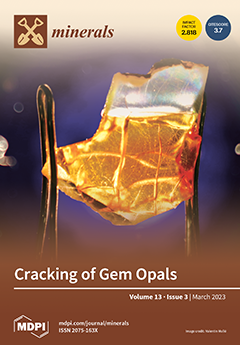In order to study the effect of the change of MgO/Al
2O
3 on the viscosity and thermodynamic properties of the chlorinated blast-furnace slag, the CaO-SiO
2-MgO-Al
2O
3-TiO
2-CaCl
2 slag system was taken as the research object, and the viscosity change rule of the chlorinated high-titanium slag was studied by using the rotating cylinder method. The thermal stability of the chlorinated high-titanium slag was quantitatively analyzed by calculating the extreme heat release rate (EHRS) of the chlorinated high-titanium slag. At the same time, the qualitative and quantitative analysis of the high-titanium slag containing chlorine was carried out by combining FTIR and Raman spectroscopy, and the mechanism of the influence of MgO/Al
2O
3 on the viscous flow characteristics of the high-titanium slag containing chlorine was revealed. The results show that when the alkalinity (R
2) of the fixed slag is 1.15, when MgO/Al
2O
3 is in the range of 0.40–0.66, the viscosity of the high-titanium slag containing chlorine presents a significant decreasing trend with the gradual increase of MgO/Al
2O
3, and the viscous flow activation energy of the slag decreases from 98.75kJ · mol
−1 to 95.21kJ · mol
−1. The heat capacity and enthalpy change of slag decrease with the increase of MgO/Al
2O
3, but the change rule of slag extreme heat release is opposite to that of heat capacity and enthalpy change. When MgO/Al
2O
3 increases, the slag extreme heat release increases from 13.413 kJ to 15.172 kJ. The content of simple structural units Q
0 and Q
1 of silicate tetrahedron in the slag gradually increases, the content of complex structural units Q
2 and Q
3 gradually decreases, and the average amount of non-bridging oxygen decreases from 1.94 to 1.79, indicating that Al
2O
3 acts as a network maker in the internal network structure of the slag. The increase of MgO/Al
2O
3 destroys the complex silicate tetrahedron structure in the slag, reducing the degree of polymerization of the slag silicate network. In addition, the transmissivity of [SiO
4]
4− tetrahedron, [AlO
4]
4− tetrahedron and T-O-T bond bending vibration band in the slag shows a decreasing trend. Within the scope of the experiment, the increase of MgO/Al
2O
3 can effectively improve the fluidity of the chlorine-containing blast-furnace slag and improve the thermal stability of the chlorine-containing blast-furnace slag.
Full article





